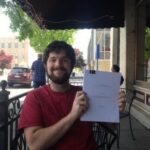Paul Krugman MasterClass review synopsis
What you’ll learn: Learn how the economy actually works; how to understand news stories about the economy; how to know what you’re talking about when you discuss economics and politics; how to predict the behavior of large groups of people.
How long does the Paul Krugman MasterClass take?: 3 hours and 56 minutes across 22 videos.
Similar Courses: Doris Kearns Goodwin: U.S. Presidential History and Leadership, David Axelrod and Karl Rove: Campaign Strategy and Messaging, Bob Woodward: Investigative Journalism, Neil DeGrasse Tyson: Scientific Thinking and Communication
Do I recommend Paul Krugman’s MasterClass? Yes! While it’s a bit wonky at times (as Krugman himself warns you), you’ll walk away with a much better understanding of the economy and your role within it.
Pop quiz: Can you explain why the economy crashed in 2008?
If you’re like me, you know there was a housing bubble, something about subprime mortgages, and something about Bear Stearns. Or a bear market. Or maybe just a bear.
The 2008 financial crisis was one of the most consequential moments in the last 20 years, and it’s still a nightmare to understand. Yet, it’s important to understand why these things happen so we can prevent them from happening again.
That’s why I enjoyed the Paul Krugman MasterClass so much. Krugman is a Nobel laureate and one of the world’s most recognizable economists, thanks to his regular New York Times column and his books like The Great Unraveling. Before I took his class, nobody could explain the 2008 crash in a way I could repeat. Krugman managed it in the first hour.
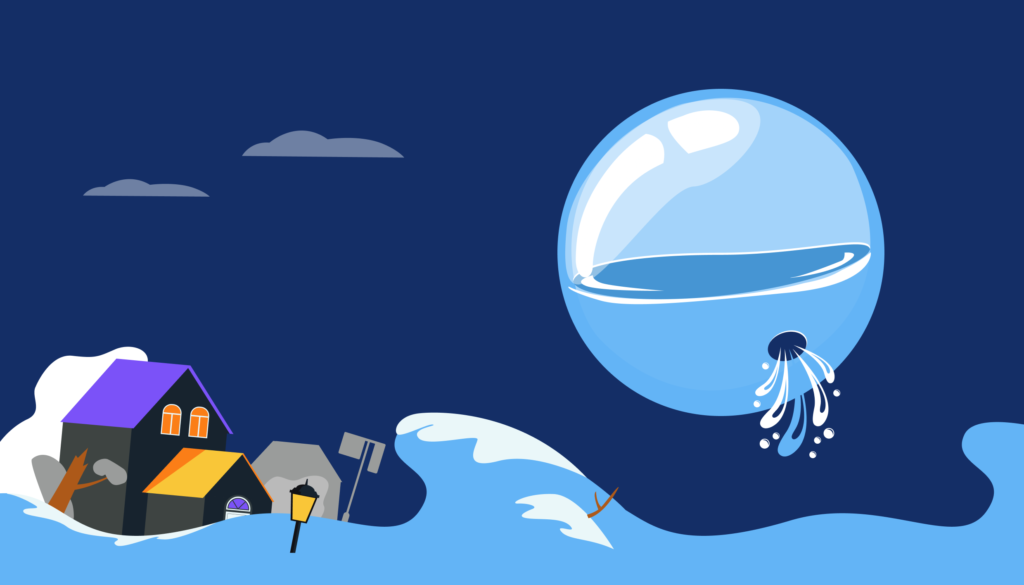
But the Paul Krugman MasterClass isn’t just about 2008. It’s about how economics can help you make sense of our chaotic world. As Krugman says, “We’re all better citizens and more satisfied people when we understand something about the world we live in.”
In this article, I’ll review the Paul Krugman MasterClass in detail and explain whether or not it’s worth your time.
Disclosure: In the interest of full transparency, Codeless uses affiliate links in our MasterClass reviews to cover our site’s costs.
Our Verdict
In addition to being packed with valuable information, Paul Krugman’s MasterClass is unique among MasterClass offerings so far — the site doesn’t have many other courses focused on understanding economics and politics.
Paul Krugman MasterClass Become a Pro at Economics
PROS
- It’s a chance to learn directly from one of the foremost economic minds of the age.
- You’ll learn how to understand systems that impact you every day.
- Krugman provides clear explanations of complex ideas with visual aids.
- You get to study the cutting edge of economic thought.
CONS
- Paul himself would probably admit that he isn’t the most charismatic speaker. So, his speaking style is sometimes awkward.
- There’s not always a clear line between accepted economic gospel and Krugman’s own research/opinions.
In this MasterClass review, you’ll learn:
A few frequently-asked questions…
Let’s answer a few frequently asked questions about the Paul Krugman MasterClass.
Do I need a subscription to access this course?
Yes. All MasterClass content requires a subscription. The good news is that once you’re subscribed, you can watch every course without any additional fees.
How long is the MasterClass?
This MasterClass consists of 22 videos and runs a total of 3 hours and 56 minutes.
Does MasterClass have a cancellation policy?
Yes — if you cancel your MasterClass subscription within 30 days of signing up, you can get a full refund.
Is the Paul Krugman MasterClass worth it?
It’s definitely worth your time if you’ve ever been curious about economic policy, globalization, or how financial systems work.
Start the Paul Krugman MasterClass
About Paul Krugman
Paul Krugman is one of the world’s most famous economists, respected both in the academic world and in the public at large. He first became interested in economics after reading the Foundation books, a series of sci-fi novels in which scientists model the behavior of whole societies.

In 2008, Krugman won the Nobel Prize in Economics for his development of the New Trade Theory, a new explanation of why economic activity concentrates in certain geographic areas. As the author or editor of 27 books and over 200 papers, he’s the second-most cited economist in college syllabi, behind only Gregory Mankiw.
Krugman is also a public figure outside academia. Many of his books are aimed at general audiences, including 2012’s End This Depression Now! and 2020s Arguing with Zombies: Economics, Politics, and the Fight for a Better Future. He writes a regular column for the New York Times, where he frequently criticizes popular policies like trickle-down economics and trade protectionism.
How much does the Paul Krugman MasterClass cost?
The only way to access any MasterClass is with a subscription — you cannot sign up for individual classes.
However, you can enjoy every MasterClass course with just one subscription, including 100+ classes and associated workbooks.
Masterclass has three subscription tiers:
- Standard Plan: For $15 per month, you get access to every MasterClass. Only one device can be logged in at one time.
- Plus Plan: For $20 per month, you can now view content on two devices at the same time. If you and one other person both want to subscribe, you can save money by sharing a Plus subscription.
- Premium Plan: For $23 per month, you can view content on up to six devices simultaneously. This is a great choice if you want to get MasterClass for your whole family, several friends, or students.
Start the Paul Krugman MasterClass
What is included in the Paul Krugman MasterClass?
Runtime: 3 hours 56 minutes
Course Value: 4/5
Lessons: 22
Supplementary materials: 79-page workbook
Supplementary workbook
The workbook that comes with this class is 79 pages long. It includes a chapter for each of the 22 lessons in the Krugman MasterClass. Each chapter ends with links to resources where you can learn more.

The MasterClass Hub
Each course comes with an associated forum called the MasterClass Hub. In the Hub, students can connect with people who have similar interests, ask questions about the course material, and explore topics through conversation.
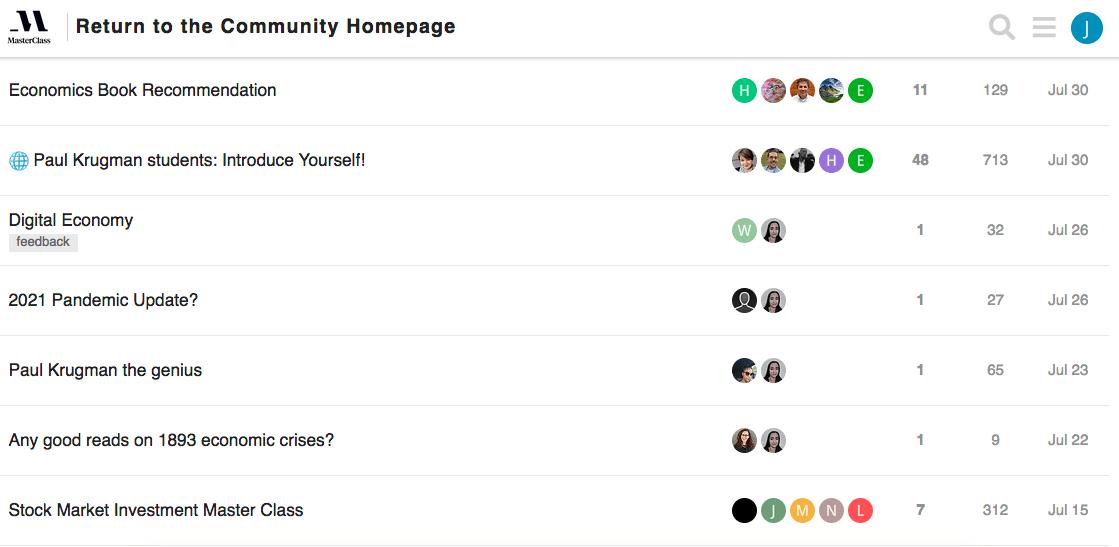
Because of the subject matter, this Hub gets political more often than most, with students arguing about the merits of various economic approaches.
A complete breakdown of the Paul Krugman MasterClass curriculum
In this section, we’ll explain the nuts and bolts of what you’re signing up for with this MasterClass.
Curriculum:
- Introduction
- What Is Economics?
- Two Fundamental Principles of Economics
- Major Developments in Economic Thought
- Understanding Macroeconomics: The Fed and IS-LM
- How ‘08 Happened
- The Economic Theory of Crises
- Economic Solutions to Crises
- Inequality: The Growing Gap
- Inequality: Our Divided Society
- Understanding Taxes
- The Economics of Technological Progress
- Health Care: The Problems
- Health Care: The Solutions
- Theories of Trade
- Understanding the Hyperglobalized World
- China: The Disruptive Miracle
- Economic Geography
- Reading Economics
- Seeing the World Like an Economist
- Writing Economics
- Closing
Course summary
Krugman starts the course by explaining what economics is and why he chooses to study it. To him, economics is the science of predicting the actions of large groups of people. His thesis: Though it’s nearly impossible to predict what one person will do, it’s much easier to predict what one million people will do.
Basic principles and babysitting
Next, Krugman lays out the two axioms of economics:
- $100 bills don’t lie in the street for long before getting picked up. In other words, people respond to incentives.
- The economy is a closed system. For someone to sell something, some other participant of the economy must buy it. In other words, every sale is also a purchase.
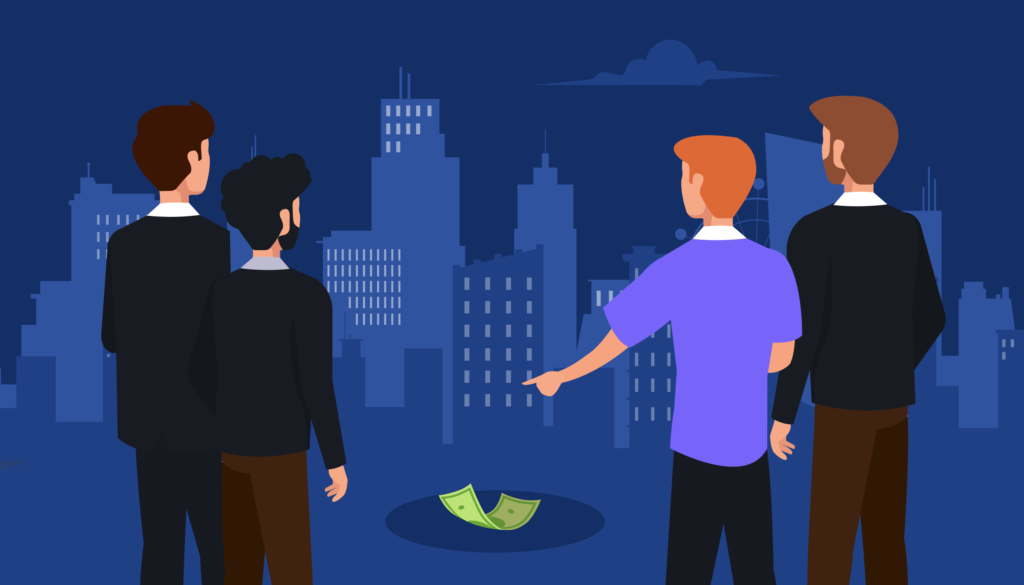
Every other development in economics grows out of those two fundamental statements. Krugman illustrates them with a parable he returns to several times: the parable of the babysitting co-op.
The babysitting co-op was an arrangement between several congressional staffers in Washington D.C., who had trouble finding people to watch their kids. Each couple took an equal share of a number of tickets. Each ticket was worth half an hour of babysitting time. Once you ran out of tickets, you had to babysit for another couple to get more.
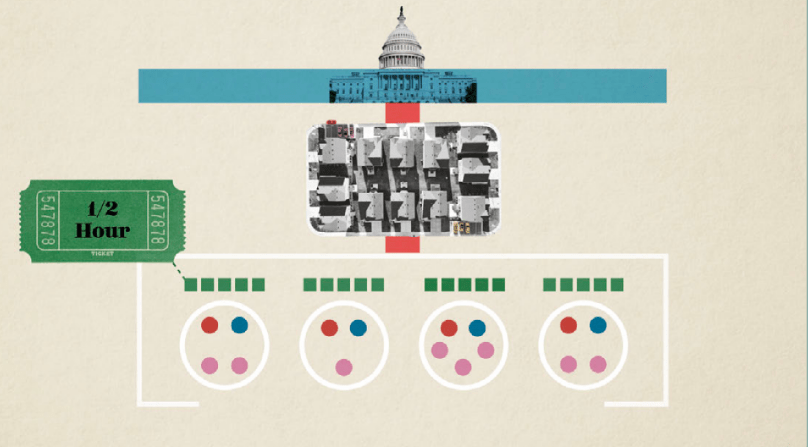
Soon, the families noticed a problem: nobody was going out. They all wanted to babysit for each other to get more tickets, but they couldn’t do that if everyone else was holding onto their tickets as well.
As Krugman points out, they created a miniature recession (side note: this was the moment I finally understood what a recession is).
In the end, the babysitters solved their problem by printing more tickets, which segues nicely into Krugman’s next topic: the role of the Federal Reserve.
What is the Fed anyway?
Before this MasterClass, I would often read about the U.S. Federal Reserve (a.k.a. “the Fed”) in the news or when making personal financial decisions. But I never understood what it actually did, except that it had the power to control interest rates. Was it a bank? A treasury? A warehouse? A think tank?
Krugman finally answered my questions by describing a core model of macroeconomic theory, based on the work of Keynes: the IS-LM curve.
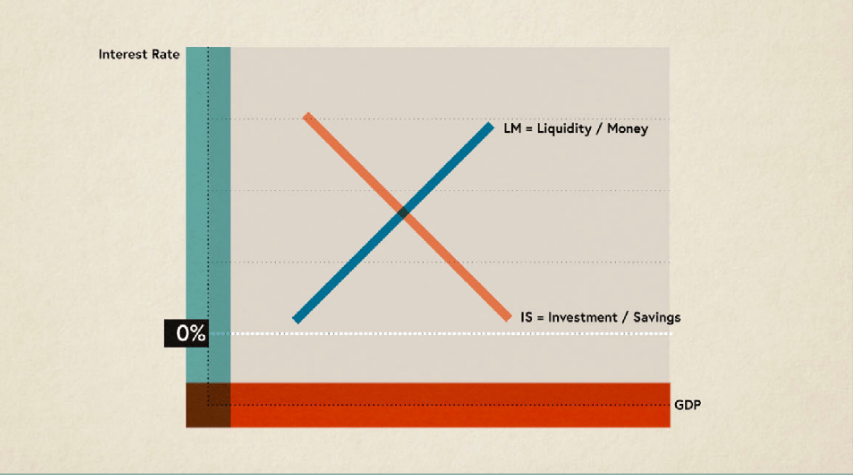
IS stands for Investment and Savings, while LM stands for Liquidity and Money. The IS-LM curve represents the relationship between interest rates and economic growth (measured by GDP).
As interest rates fall, people make more purchases, and the economy grows. As the economy grows, banks make more investments. They seek money for these investments by offering higher interest rates. The two values naturally move toward equilibrium, the point on the map that should — in theory — represent reality.
The Federal Reserve doesn’t have the power to decree the national interest rate. Instead, they control it through supply and demand: printing money to lower the amount of interest needed to promote investment or buying money back from banks to contract the money market and raise interest rates.
On the graph, printing money moves the LM line to the right. That depresses interest rates, which in turn grows the economy. The Fed uses this power to keep the economy stable.

At least, that’s how it’s supposed to work. But if the IS-LM curve reflects reality, how did we have a financial crisis in 2008?
I won’t spoil it all for you, but Krugman then delves into the anatomy of a crisis and what actually happens when you put your money into the bank (spoiler: it doesn’t just stay here).
Economics in the global age
For the remainder of the MasterClass, Krugman applies his expertise to various pressing economic issues, like income inequality, health care, and the Chinese economic shock.
He ends the class by explaining how to think like an economist. The conclusion of both Krugman’s MasterClass and his career is that economics should be disruptive: “If everything you see when you look at economics confirms your initial view of the world, then you’re doing it wrong.”
What I learned
I took a microeconomics course in college but had always found it difficult to connect those conclusions with the economic trends I read about in the news. Paul Krugman helped me build an economic “theory of relativity” that connects the macro and micro.
5 takeaways from this MasterClass
1. Economics is psychology on a grand scale.
You can’t tell what a person is going to do, but you can tell what they’re likely to do. Predictable reactions can help you guess how whole populations will behave.
2. Economics can be restrictive but also beautiful.
As Krugman says, “Economics is often called the Dismal Science because a lot of it is about what you can’t do.” But it also offers moments of clarity that help you understand why the world is the way it is.
3. A crisis generally happens the same way every time.
The crises of 1929 and 2008 both happened for very similar reasons: people abruptly lost faith in their financial institutions. The window dressing is different, but the cause of one crisis can tell us how the next one is likely to go.
4. Policy matters.
The government has the ability to influence the overall success of the economy. It sometimes seems like the Fed is just spitting into the wind, but it has powerful tools at its disposal (within certain limits).
5. The general narrative about economic issues is overwhelmingly wrong.
Many of the economic statements that we take as gospel — for example, that deficit spending is always bad or that printing money always causes runaway inflation — have no basis in reality. An economist has to look at the real world and only the real world.
Start the Paul Krugman MasterClass
Memorable quotes from this MasterClass
“Something that worked fine as long as the economy was on an even keel suddenly turned into a doomsday machine.”
Lesson 6: How ‘08 Happened
“We have, for the past two centuries, become accustomed to a world in which each decade, the world is richer than the one before.”
Lesson 4: Major Developments in Economic Thought
“Economics is complex, and predictions are hard, especially about the future. That means that from time to time, even the best economic analysts will be wrong.”
Lesson 19: Reading Economics
Paul Krugman MasterClass pros and cons
Not every MasterClass is for everybody. If you’re on the fence about whether to study with Paul Krugman, here are the primary pros and cons.
Pros
- It’s a chance to learn directly from one of the foremost economic minds of the age.
- You’ll learn how to understand systems that impact you every day.
- Krugman provides clear explanations of complex ideas with visual aids.
- You get to study the cutting edge of economic thought.
Cons
- Paul himself would probably admit that he isn’t the most charismatic speaker. So, his speaking style is sometimes awkward.
- There’s not always a clear line between accepted economic gospel and Krugman’s own research/opinions.
Do I recommend this MasterClass?
I definitely do. In addition to being packed with valuable information, it’s unique among MasterClass offerings so far — the site doesn’t have many other courses focused on understanding economics and politics.

